Many have accused Bernstein of pretentiousness in associating his Serenade with Plato’s Symposium, suggesting that he merely tacked on the highfalutin subtitle after he had already composed it. Critics typically cite discrepancies between Plato’s classic and the Serenade, arguing that one has little to do with the other: compared with Plato’s book, the movements are out of order and the character of the music does not always match that of the ancient Greek dialogue.
Bernstein, however, was insistent, and later even said that the work was “originally called Symposium” rather than Serenade. “I was dissuaded from that title because people said it sounded so academic. I now regret that. I wish I had retained the title so people would know what it is based on…” After first encountering Plato’s work during his student years, Bernstein reread it in 1951 during a vacation in Cuernavaca, but did not begin composing Serenade until 1953. Perhaps memory lapses account for Bernstein’s divergences from Plato, but it is equally possible that Bernstein is commenting of Plato’s work through music, presenting his own interpretation of its contents.
A Not-So-Secret Secret
An alternative reason for Bernstein’s interest in Plato’s Symposium is seldom mentioned in literature about the piece. Far from being a dry philosophical treatise that many make it out to be, Plato’s Symposium is a short, readable and highly amusing depiction of a group of friends at a party. They are engaged in a discussion about a topic as interesting today as it was two and a half thousand years ago: love. However, as ancient Athenians, nearly all of the speakers in Plato’s Symposium assume as a matter of course that they are speaking of love in a homosexual male context.
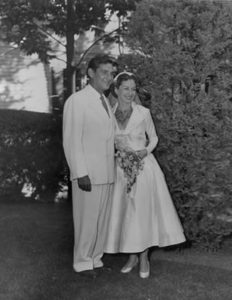
Leonard Bernstein’s rereading of Plato’s Symposium occurred just a few months before his marriage to actress and television star Felicia Montealegre. His biographers debate whether he was bisexual or homosexual, but there is no question that Bernstein was strongly attracted to other men and had frequent affairs with them throughout his life. Felicia was well aware of Bernstein’s orientation, but wanted to marry him anyway, possibly hoping she could change him or at least curb his behavior. Bernstein must have had serious reservations about the marriage—he had already broken off a previous engagement with Felicia. In the end he went through with it, likely motivated by a mixture of real affection for Felicia, internalized homophobia and a desire to appear respectable to orchestras in search of music directors. Apparently, he initially intended to give up his old habits, though he ultimately did not succeed.
One daughter and a couple of years later, Bernstein began working on the piece to which he would give the unwieldy title of Serenade for Violin, Strings, Harp and Percussion (after Plato’s Symposium). Most people would assume that Plato’s Symposium was merely a dusty old classic, while those in the know might recognize a coded expression of Bernstein’s sexuality. In addition to any personal motivations for composing it, the work also simultaneously fulfilled a long-delayed commission from the Koussevitzky Foundation and violinist Isaac Stern’s dogged requests for a violin concerto. In any case, Berstein’s music and Plato’s dialogue make for an interesting side-by-side comparison.
Bernstein vs. Plato
The first movement of the piece is titled “Phaedrus: Pausanias,” after two characters from Plato’s Symposium. In Symposium, Phaedrus expresses the view that love inspires men to virtue as they seek to prove themselves to their beloveds. Bernstein evokes this with a tender, introspective introduction that begins with the soloist alone:
The violin plays a gentle rocking figure that is the germinal seed of the entire piece; nearly all of the melodic material that follows evolves from it. When the strings enter, they reveal that the violinist’s solo was actually the subject of a fugato, which builds in intensity until the music breaks into a faster tempo.
This new section corresponds with Pausanias, an Athenian lawyer from Plato’s Symposium who adds a qualification to Phaedrus’s praise of love by contrasting its heavenly and common forms, saying, “Evil is the vulgar lover who loves the body rather than the soul…and therefore when the bloom of youth which he was desiring is over, he takes wing and flies away, in spite of all his words and promises; whereas the love of the noble disposition is life-long, for it becomes one with the everlasting.” In his own commentary on Serenade, however, Bernstein says, “Pausanias continues by describing the duality of the lover as compared with the beloved”—which is not really accurate.
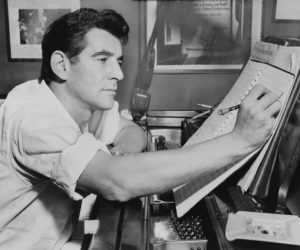
Did Bernstein misremember Pausanias’s speech? Or did he intentionally twist the meaning of it? In any case, the music does depict a duality of some kind through two contrasting themes: the first is driving, athletic and impetuous; the second, marked “dolce con grazia” (“sweetly and gracefully”) is coy and playful. The two themes alternate and evolve as the movement progresses.
The second movement is titled Aristophanes, after the Athenian comic playwright. In Plato’s Symposium, he invents a myth about love in which human beings were once double: “the primeval man was round, his back and sides forming a circle; and he had four hands and four feet, one head with two faces, looking opposite ways, set on a round neck and precisely alike; also four ears, two privy members, and the remainder to correspond.” Some of the primordial people were male/female, others male/male and others female/female. Eventually they angered the gods, who as punishment clove them in twain, and ever since people have been searching for their other halves. This, he says, is the origin of love.
Bernstein notes Aristophanes’ role as “that of the bedtime-storyteller, invoking the fairy-tale mythology of love. The atmosphere is one of quiet charm.” Indeed, this movement begins with a quiet, charming melody with a Mahlerian lilt. A contrasting central section features a more angular, scherzando melody—perhaps this is the splitting of the primordial humans? The opening melody then returns, played by the soloists with airy harmonics (notes produced by barely touching the violin’s strings).
Next comes Eraximachus, a physician who delivers a brief yet rambling disquisition on love from the medical point of view. Somehow while discussing the reconciliation of opposites, he digresses on a tangent about music, saying “For harmony is a symphony, and symphony is an agreement; but an agreement of disagreements while they disagree there cannot be; you cannot harmonize that which disagrees….and thus music, too, is concerned with the principles of love in their application to harmony and rhythm.” Such is the tenor of his speech.
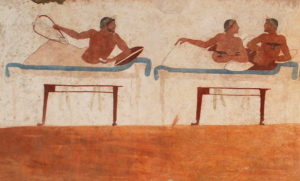
For this movement, Bernstein wrote “an extremely short fugato-scherzo, born of a blend of mystery and humor.” The soloist’s virtuoso passagework zigzags across the instrument, much as Eriximachus darts from one topic to another. One divergence from Plato is the placement of this movement; in Symposium, Eriximachus speaks before Aristophanes (to give him time to recover from a bout of hiccups). There is a purely musical reason for Bernstein’s reordering of the speakers, however; he needed the slower tempo of the Aristophanes movement to break up the fast ending of Pausanias from the fast music of Eraximachus.
The next movement is named after Agathon, a wealthy young poet held to be the most attractive man at the party. In Plato’s Symposium, Agathon gives a rather flowery speech in which he describes love as a beautiful youth not unlike himself, saying, “he walks not upon the earth…but in the hearts and souls of both gods and men, which are of all things the softest…where there is hardness he departs, where there is softness there he dwells; and nestling always with his feet and in all manner of ways in the softest of soft places, how can he be other than the softest of all things?”
For Bernstein, “Agathon’s panegyric” is “Perhaps the most moving speech of the dialogue…” Indeed, this movement is the heart of the entire work, and possesses an emotional depth far beyond what is found in Agathon’s speech in Symposium. Musically, Bernstein described it as “a simple three-part song.” It begins with the gentle, rocking motif from the work’s opening in the orchestra, above which the soloist plays a long melody of great intimacy and vulnerability. An extended passage for orchestra becomes increasingly intense, building to a cadenza for soloist alone. The opening melody then returns, fading away on a high harmonic.
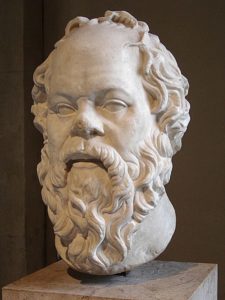
In Plato’s Symposium, Socrates’ speech is the climax of the work as he gradually leads his listeners to admire the abstract, intellectual ideal of beauty itself. Bernstein seems not to have been as carried away by Socrates’ speech as Plato would have hoped, as it is reduced to a rather austere introduction to the last movement. Bernstein seems to have preferred Agathon’s poetic vision of love to Socrates’ philosophical one, noting that “his seniority adds to the feeling of didactic soberness in an otherwise pleasant and convivial after-dinner discussion.”
After a stern opening for orchestra, the violin soloist engages in a dialogue with the principal cellist, which represents Socrates’ dialogue with Diotima, a wise woman from whom Socrates says he learned everything he knows about love (presumably Socrates is the cello and Diotima the violin). This leads to a mysterious, rarefied passage for the solo violin, perhaps corresponding to Diotima’s “contemplation of beauty absolute…the true beauty…pure and clear and unalloyed, not clogged with the pollutions of mortality and all the colors and vanities of human life…”
Just as Socrates finishes his speech, Plato relates that “suddenly there was a great knocking at the door of the house, as of revelers, and the sound of a flute-girl was heard….they heard the voice of Alcibiades resounding in the court; he was in a great state of intoxication, and kept roaring and shouting ‘Where is Agathon? Lead me to Agathon…”
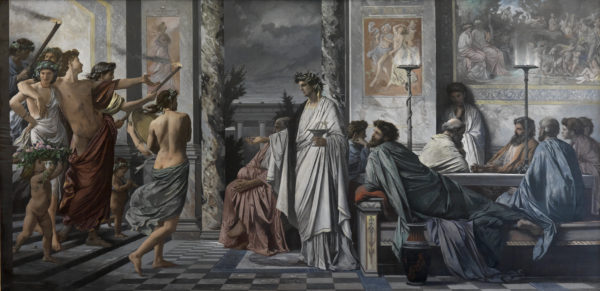
Alcibiades was a dashing, young, Athenian general who would later play a controversial role in the Peloponnesian Wars (defecting to Sparta at one point). Ironically, Plato’s Symposium ends with Alcibiades’ own speech, in which he confesses that, despite Socrates’ unattractive bald head and pug nose, he fell madly in love with the philosopher thanks to his way with words. Socrates, however, was unmoved by this man who fundamentally failed to understand his philosophy.
Bernstein, however, is mostly concerned with creating an atmosphere of wild, Dionysian revelry in the finale of his Serenade, though there are occasional hints of underlying anxiety. Bernstein writes, “The famous interruption by Alcibiades and his band of drunken revelers ushers in the Allegro, which is an extended rondo ranging in spirit from agitation through jig-like dance music to joyful celebration. If there is a hint of jazz in the celebration, I hope it will not be taken as anachronistic Greek party-music, but rather the natural expression of a contemporary American composer imbued with the spirit of that timeless dinner party.”
A Hermeneutic Mess
Bernstein may have said his Serenade was “after Plato’s Symposium,” but in the end it seems wholly Bernstein’s Symposium. Bernstein diverges so much from Plato that he has effectively created his own retelling of the story with a new meaning and message.
Or maybe Bernstein’s Serenade was about something else entirely, and the reference to Plato was a smokescreen, or a metaphor for some other, hidden source of inspiration. Bernstein’s music could just as easily depict a party in mid-century New York as a party in ancient Athens. He would not have been the first to publicly suggest one program while privately thinking of another. For instance, Rachmaninoff’s symphonic poem, The Crag, was supposedly inspired by a poem by Lermontov, but he later revealed that it was actually inspired by a Chekhov short story that used a quote from Lermontov’s poem as an epigram.
Or perhaps his critics are right, and Bernstein tacked on the name “Symposium” after he had already written a purely abstract piece of music. It can certainly be enjoyed as such, and in any case, it is the quality of the music that matters most—if it were not good music on its own, no one would care what inspired it. Huphrey Burton, one Bernstein’s biographers and a man who knew him well, suggested that the Serenade “can also be perceived as a portrait of Bernstein himself: grand and noble in the first movement, childlike in the second, boisterous and playful in the third, serenely calm and tender in the fourth, a doom-laden prophet and then a jazzy iconoclast in the finale.”
Even Bernstein was known at times to voice the opinion that music expresses nothing but itself. Nevertheless, it seems unfair to completely ignore his remarks about his Serenade. They certainly provide interesting food for thought, as was likely his intention.
Don’t miss Bernstein’s Serenade, performed by Hilary Hahn on February 23, 24 and 25 at our European Tour Preview Concerts! Get tickets and more information at houstonsymphony.org.



